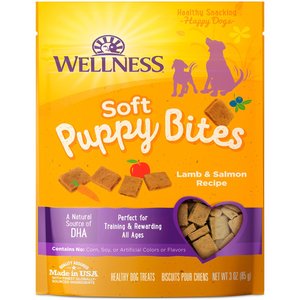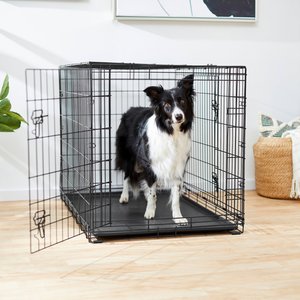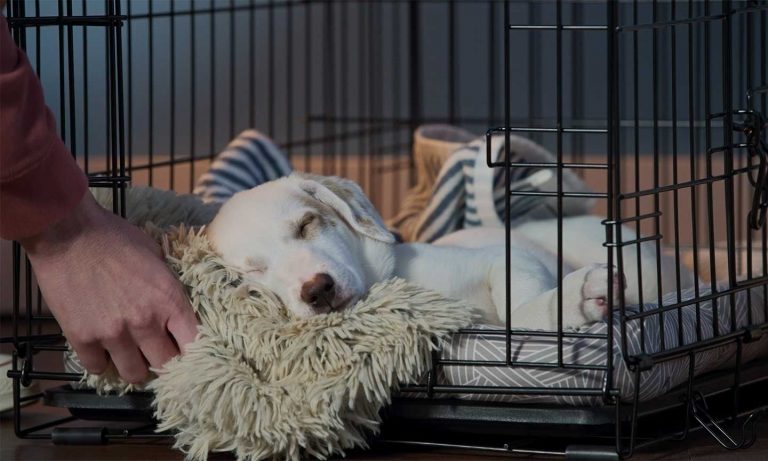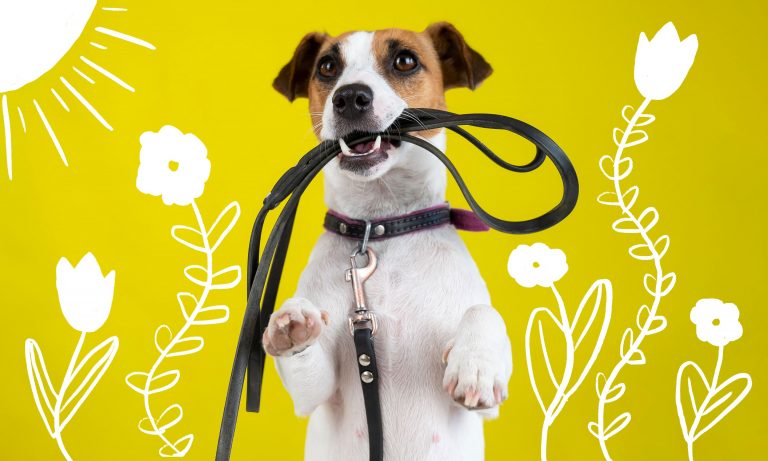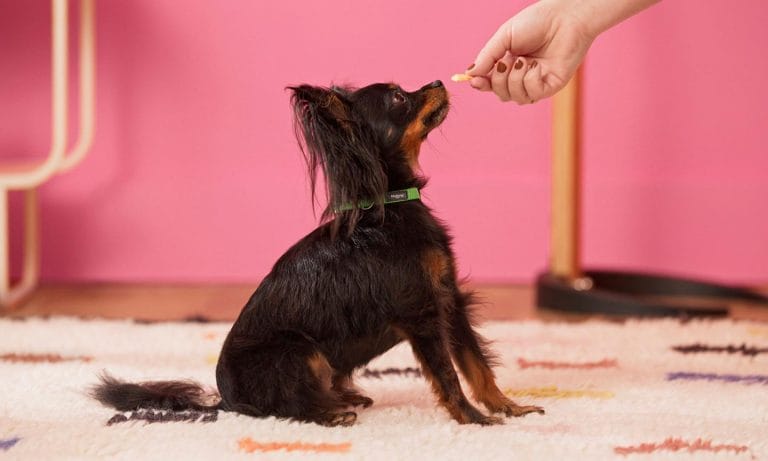House-training, aka potty training, may be one of the most important things you do with your new puppy. Everyone—whether two- or four-legged—is happier when puppy knows the rules about where and when to do their business. So, how do you potty train a puppy?
As you work on potty training for a puppy, keep in mind that it’s natural for young dogs to view the whole world as one giant potty area. Potty training is a process that takes both time and patience, but you and your puppy can master this important task.
So how long does it take to potty train a puppy? That largely depends on how consistent you are and how long your puppy can hold it. (Small breed puppies typically have a harder time holding it than large breed puppies, for example.)
In This Guide:
Supplies for Potty Training a Puppy
- Collar or harness and leash
- Dog pee pads (optional)
- Tasty, small-size dog treats
- Floor or carpet cleaner for pet stains
- Dog crate or dog pen
How To Potty Train a Puppy
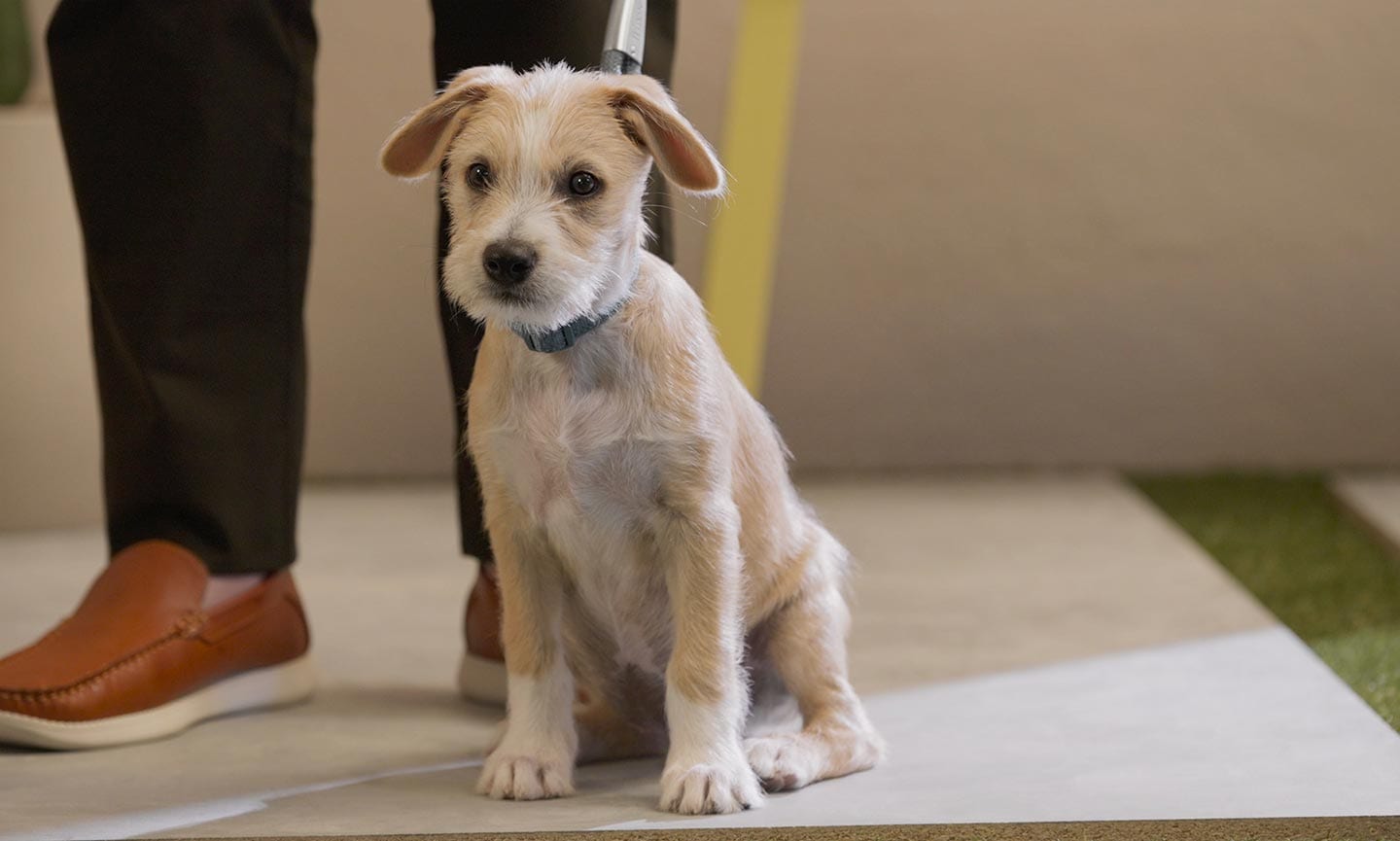
1. Take Your Puppy Out at Least Once Every 30 Minutes
Take your puppy out on leash. Being on leash helps your puppy learn to potty on leash in general, which is useful because you’ll probably want your dog to potty on walks at some point.
It also keeps your puppy from running around and getting distracted by all the interesting things around them when they’re outside, instead of focusing on finding a place to eliminate.
2. Wait up to Five Minutes
Stand still in one spot, in an area where it’s OK for your puppy to potty. Quietly watch your puppy for five minutes.
By standing still, you keep your puppy in a small enough area that they will get bored with exploring fairly quickly and focus on pottying faster.
By keeping quiet, you help your puppy focus on pottying, instead of interacting with you.
3. Praise and Offer a Treat if Your Puppy Pees or Poops
If your puppy eliminates within five minutes, it’s time to celebrate! Break out the treats and give them lots of verbal praise.
Wait until your puppy has finished pottying to do all this, of course. You don’t want to interrupt them, only to have them finish that potty indoors!
If your puppy does not pee or poop within five minutes, that’s OK. Take them back inside to a confinement area such as a crate or pen for 10 to 20 minutes. After 10 or 20 minutes, go back to Step 1.
4. Give Your Puppy Off-Leash Fun Time (if Possible)
Fun time can take place outdoors if it’s a safe area to be off leash (and if your puppy likes being outdoors), or indoors under supervision if outdoors is not an option (or if your puppy doesn’t want to stay outdoors).
Giving your puppy off-leash fun time once the puppy pees or poops teaches the puppy that pottying leads to more fun.
Most importantly, avoid the common mistake of confining your puppy right after they potty. If you bring the puppy back to their confinement area right after a successful mission, they learn that pottying ends the fun. Then they may start to wait longer and longer to potty, which is the opposite of what you want, right?
5. Repeat These Steps Throughout the Day
Give your puppy lots of chances to potty in an appropriate potty area. Then use positive reinforcement (treats, play, praise) to encourage your puppy to keep pottying in those areas.
The more times your puppy gets it right (and the fewer times your puppy has an accident), the faster your puppy will learn the routine.
6. Supervise or Manage Your Puppy Between Potty Breaks
Until your puppy is fully house-trained, make sure your puppy is always either managed or supervised.
Managing your puppy can mean several things:
- Crating your puppy in a dog crate
- Confining your puppy to a small area using dog gates, a pen, or tether
Each of these options encourages your puppy to hold it, because they don’t like to play where they’ve pottied. Plus, it helps keep messes contained.
Supervising your puppy is more involved than you may think. This means you're actively watching your puppy—not just sitting in the same space as they are.
To effectively supervise your puppy, you should have eyes on them and be interacting with them consistently. This helps you notice their cues that it’s time for a potty break.
The same is true for outside supervision. Without watching your puppy at all times, you may miss it when they pee or poop—and waste an opportunity for positive reinforcement.
Important Note on Crate Training
A young puppy should never be crated for more than a couple of hours, except overnight. Your puppy might not be able to hold it very long.
If they’re crated for too long, they may start pottying in the crate out of desperation.
Keep crate time to a couple of hours or less, except at night. Listen for “I need to potty” barks or whines in the middle of the night, too, so you can give your puppy an overnight potty break whenever necessary.

Puppy Potty Training Cheat Sheet
- Take your puppy to a potty area (outdoors or indoors) on leash at least once every 30 minutes while you are home and awake. At night, one or two outings are enough for most puppies.
- Stand still and quietly watch to see if the puppy pees or poops.
- Praise and offer a treat as soon as the puppy pees or poops outside. If the puppy does not pee or poop, that’s OK—take the puppy back to an indoor confinement area for 10 to 20 minutes, and then outside again.
- After the puppy pees or poops, play with the puppy outdoors, or give puppy up to 15 minutes of carefully supervised time in the house (whichever the puppy prefers).
- Repeat these steps throughout the day.
How Long Does It Take to Potty Train a Puppy?

Every puppy is different, and the amount of time it takes them to learn potty training also depends on how consistent their pet parent is with training.
For that reason, there’s really no "normal” amount of time to spend house-training. Some dogs learn in a week or two, while others may need months or longer to become fully trained.
Tips To Speed Up House-Training a Puppy

Keep Track of Your Puppy’s Potty Habits
Create a house-training chart or use a notepad to take notes about when and where your puppy potties, so you can learn their patterns. This information will help you learn which times of day your puppy is most likely to potty, when and where they tend to have accidents, and when they probably don’t need to go to the potty area.
In time, the chart will help you figure out what areas should be off-limits for now and if you can skip a 30-minute potty break here and there.
Download our Puppy Potty Training Chart printable, to help you keep track.
Take Them Out at Likely Potty Moments
In addition to their regular 30-minute intervals, give your pup time in their potty area at these likely potty times:
- After eating
- After drinking
- After five to 10 minutes of play or other vigorous activity
- Immediately after waking up from a nap
Get Your Puppy on a Feeding Schedule
One good way to get pottying under control is to put your puppy on a feeding schedule. With a feeding schedule, you give your puppy regular meals, at regular times, rather than leaving the food bowl out all the time.
In addition to pottying right after eating, many puppies potty again at a regular period of time after eating. If you note a) when you feed your puppy and b) when your puppy potties in between meals, you can start to find patterns. Use your notes to make sure your puppy always goes out to a potty area at the right times after eating.
The right feeding schedule depends on age, size, and more, so ask your veterinarian to help you figure out a feeding schedule for your puppy.
Download our Puppy Feeding Schedule printable.
Clean Up Past Accidents Thoroughly
The odor from past accidents is like a “restroom” sign for your dog. Clean up dog pee and poop using a cleaner designed for pet stains, such as Nature's Miracle or Skout's Honor.
After you clean, get on your hands and knees and sniff the area to make sure the smell is gone. You may also want to sniff other areas, just in case—you may be amazed at how many “missed” pee spots you find!
What if My Puppy Potties in the Wrong Place?
If you see your puppy having an accident, calmly take the puppy outside. When they finish eliminating outside, praise and offer a treat for going potty in the right place.
Fight the urge to yell or scold! Punishing your puppy, whether by yelling and scolding or pushing the puppy’s nose into the urine, will not help.
Punishing your puppy usually teaches them to pee and poop where you can’t see them. In other words, they won’t stop pottying in the house; they’ll just hide before they do their business. This is because puppies often misinterpret punishment to mean they shouldn't potty in front of you. The nuance that the punishment was about pottying indoors may be totally lost on them.
Potty Training FAQs
Q:Why is my dog regressing with potty training?
A:: If your puppy is regressing with potty training, the first thing to do is review your house-training chart. Have you started giving your puppy fewer potty breaks? Has the feeding schedule changed? Has anything else changed that might affect the puppy’s house-training?
Pay attention to when and where the accidents are happening. If you notice accidents are always happening in the same room, limit your puppy’s access to that room. If the accidents are always happening at the same time, add a potty break at that time.
Q:Do puppy potty-training sprays work?
A:Potty-training sprays, which are sprays with a unique smell that help a puppy learn where to potty, can be helpful in some cases. The smell of urine or feces can be like a restroom sign. Potty-training sprays let you set up restroom signs in designated potty areas.
Q:At what age should my dog be potty trained?
A:The age when a dog should be potty trained varies by breed and size, but most dogs can be fully potty trained by the time they are about 9 months to 1 year old.
Note that “fully potty trained” means no accidents at all unless the dog is sick or asked to hold it for too long. A dog who is still having occasional accidents is considered not fully potty trained yet.
Q:Can dogs potty train themselves?
A:It would be nice if dogs could potty train themselves, but it’s extremely rare. Sometimes young puppies living with older, house-trained dogs do learn to potty outdoors with their older “sibling,” but that doesn’t prevent them from pottying indoors too. Pretty much all pet parents will need to manage their puppy and follow a regular potty-break schedule to get their puppy 100 percent potty trained.
Q:Can you potty train a puppy in seven days?
A:One week is a very short amount of time to expect a puppy to become fully potty trained. Many puppies will need longer than seven days to learn to go potty outside every time. The amount of time it takes to potty train a puppy depends on both the puppy and the pet parent’s training methods and consistency.
If you suspect your pet is sick, please call your vet immediately. For health-related questions, always consult your regular veterinarian when possible as they can make the best recommendations for your pet. (If you need help connecting with a vet, try Connect With a Vet.)
This content was medically reviewed by Molly Price, DVM, Chewy veterinarian.
More Puppy Training:
Share:




